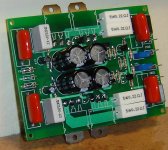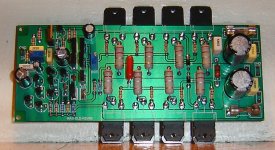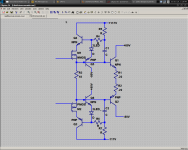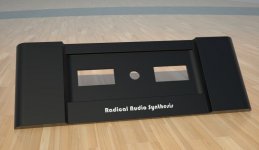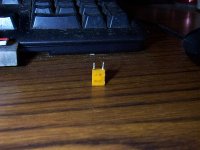With a totally independent supply and a combined load for 2 channels of maybe a hundred mA ,you should not have much "rail sag" to contend with anyways. With my HV supply , I intend on going 120V DC +unregulated and regulating down to 100V rails. looking at nico's circuit , it seems to have voltage regulation and is part C-multiplier.
OS
You are most welcome OS
Nico
Here is the PCB pic. I use them in a lot of my applications. Works good and has slow start up which iliminates pop on speakers, also slow decay. CM works great also. If you want Gerbers you are welcome ofcourse
Nico
As my 17 YO granddaughter would say: OMG - this is sooooooo bitch'n!

OS, my preference would be to use a shunt regulator for HV frontends, since they are inherently current-limited and forgiving, and are supposed to have better performance in most areas.
Nico, I notice you specify 1uF polycarbonate caps for the output decoupling... How do you get those?
- keantoken
Nico, I notice you specify 1uF polycarbonate caps for the output decoupling... How do you get those?
- keantoken
ELD was my version of this amp for some years.
RAS ELD has been my Goldmund for more than 1 year but is now a commercial amp with a few changes. It does sound pretty handsome and it contains almost everything that has been mentioned in these threads. The commercial equipment contains a regulator on each channel as well as a few other refinements which I cannot show here, but what I show is a complete working machine in every-day use.
Some may not call it musical for what that statement means, but it is like water, it has no taste, no color, no flavor, no smell and, it gives what is inputted, no more no less. Some my prefer flavored drinks others fizzy drinks, etc, this amp does not do that, it is completely vanilla.
Maybe you could use some of the ideas from it. I have not been a fet input fan, I stick to BJTs, of course one change is front end that now uses 2SC2240 and 2SA970. I will post some sims below, not that they are of much use in practice, but gives an indication.
RAS ELD has been my Goldmund for more than 1 year but is now a commercial amp with a few changes. It does sound pretty handsome and it contains almost everything that has been mentioned in these threads. The commercial equipment contains a regulator on each channel as well as a few other refinements which I cannot show here, but what I show is a complete working machine in every-day use.
Some may not call it musical for what that statement means, but it is like water, it has no taste, no color, no flavor, no smell and, it gives what is inputted, no more no less. Some my prefer flavored drinks others fizzy drinks, etc, this amp does not do that, it is completely vanilla.
Maybe you could use some of the ideas from it. I have not been a fet input fan, I stick to BJTs, of course one change is front end that now uses 2SC2240 and 2SA970. I will post some sims below, not that they are of much use in practice, but gives an indication.
Attachments
Last edited:
Shouldn't R8 and R30 go to negative rails or some bias string, to help linearize the electrolytics? Currently they do nothing.
- keantoken
- keantoken
Shouldn't R8 and R30 go to negative rails or some bias string, to help linearize the electrolytics? Currently they do nothing.
- keantoken
Hi Kean when I use electrolytics in an back-to-back config I bias them slightly. This makes them last longer as the electrolyte remains activated. I learned this from an old man years ago and keep on doing this., Why I used R30 is a waste obviously.
Last edited:
RAS ELD has been my Goldmund for more than 1 year but is now a commercial amp with a few changes. It does sound pretty handsome and it contains almost everything that has been mentioned in these threads. The commercial equipment contains a regulator on each channel as well as a few other refinements which I cannot show here, but what I show is a complete working machine in every-day use.
Some may not call it musical for what that statement means, but it is like water, it has no taste, no color, no flavor, no smell and, it gives what is inputted, no more no less. Some my prefer flavored drinks others fizzy drinks, etc, this amp does not do that, it is completely vanilla.
Maybe you could use some of the ideas from it. I have not been a fet input fan, I stick to BJTs, of course one change is front end that now uses 2SC2240 and 2SA970. I will post some sims below, not that they are of much use in practice, but gives an indication.
I use the regulator shown earlier. It works wonders compared to raw caps only.
BTW I do not say use this design, I say see if there is something to learn from it, if not then scrap the idea, it is not important to me. If there are ways to improve it I will be pleased also.
Regarding expense to regulate, although the change is small it remains significant in perceived enjoyment. It is a commercial amplifier and I am not competing with the Chinese on cost. My chasis is machined from solid 20 mm aluminium plates and uses an 850 VA transformer. Cost is not really an issue, call me a thief if you like 🙂
Regarding expense to regulate, although the change is small it remains significant in perceived enjoyment. It is a commercial amplifier and I am not competing with the Chinese on cost. My chasis is machined from solid 20 mm aluminium plates and uses an 850 VA transformer. Cost is not really an issue, call me a thief if you like 🙂
R8/R10
For proper implementation the resistors R8/R10 should be connected to the negative rail, I agree with Keantoken.
For proper implementation the resistors R8/R10 should be connected to the negative rail, I agree with Keantoken.
RAS ELD has been my Goldmund for more than 1 year but is now a commercial amp with a few changes.
This is closer to my design than the Goldmund.
Anyway Kean that is my contribution to your thread, I shall remain as an observer and see what comes out the sausage machine.
Cheers
Nico
Cheers
Nico
Thank you for your input Nico. There are several ways to improve your regulator, but for lack of time I would prefer to "let it be good enough".
- keantoken
- keantoken
This is looking like this could be something special.
When people start to also consider the role of the power supply to the total package. Then there is a very good chance of success.
My vote goes for a shunt reg on the front end.
Hi Nico
I suppose I would be biased then if I said I like your design more than the topolgy of the Goldmund.
I dont have any capacitors in the feedback loop. There are other differeces, but basically the same topology to mine.
When people start to also consider the role of the power supply to the total package. Then there is a very good chance of success.
My vote goes for a shunt reg on the front end.
Hi Nico
I suppose I would be biased then if I said I like your design more than the topolgy of the Goldmund.
I dont have any capacitors in the feedback loop. There are other differeces, but basically the same topology to mine.
Last edited:
This is looking like this could be something special.
When people start to also consider the role of the power supply to the total package. Then there is a very good chance of success.
My vote goes for a shunt reg on the front end.
Hi Nico
I suppose I would be biased then if I said I like your design more than the topology of the Goldmund.
I dont have any capacitors in the feedback loop. There are other differeces, but basically the same topology to mine.
I can accept that, but I am not always so sure in a commercial environment of what a consumer plugged into the amp, it can vary from an iPod to a Wadia. Direct connect can present a problem in that his speakers stands permanently proud of the box😱
On mine I have zero capacitors because my equipment has no output offset. I am lucky
- Home
- Amplifiers
- Solid State
- Goldmund Mods, Improvements, Stability
